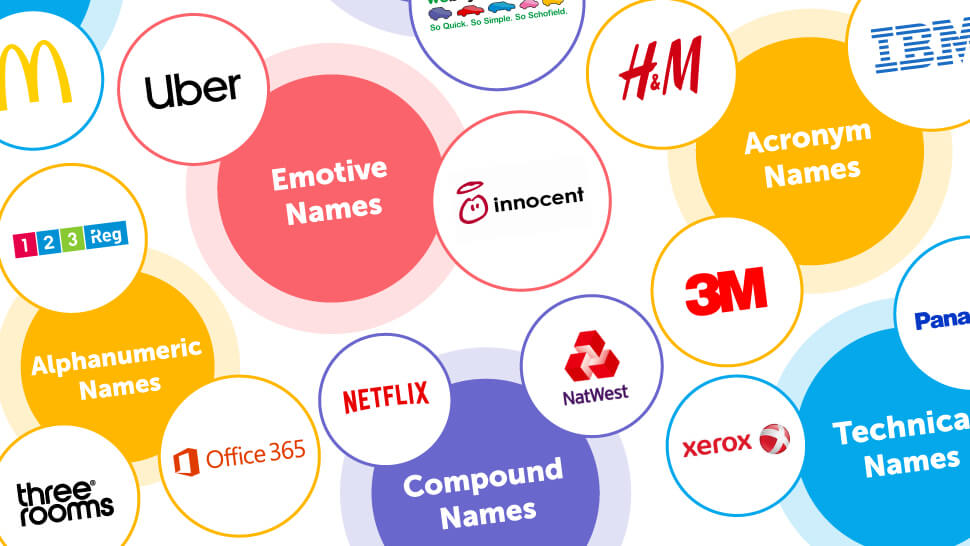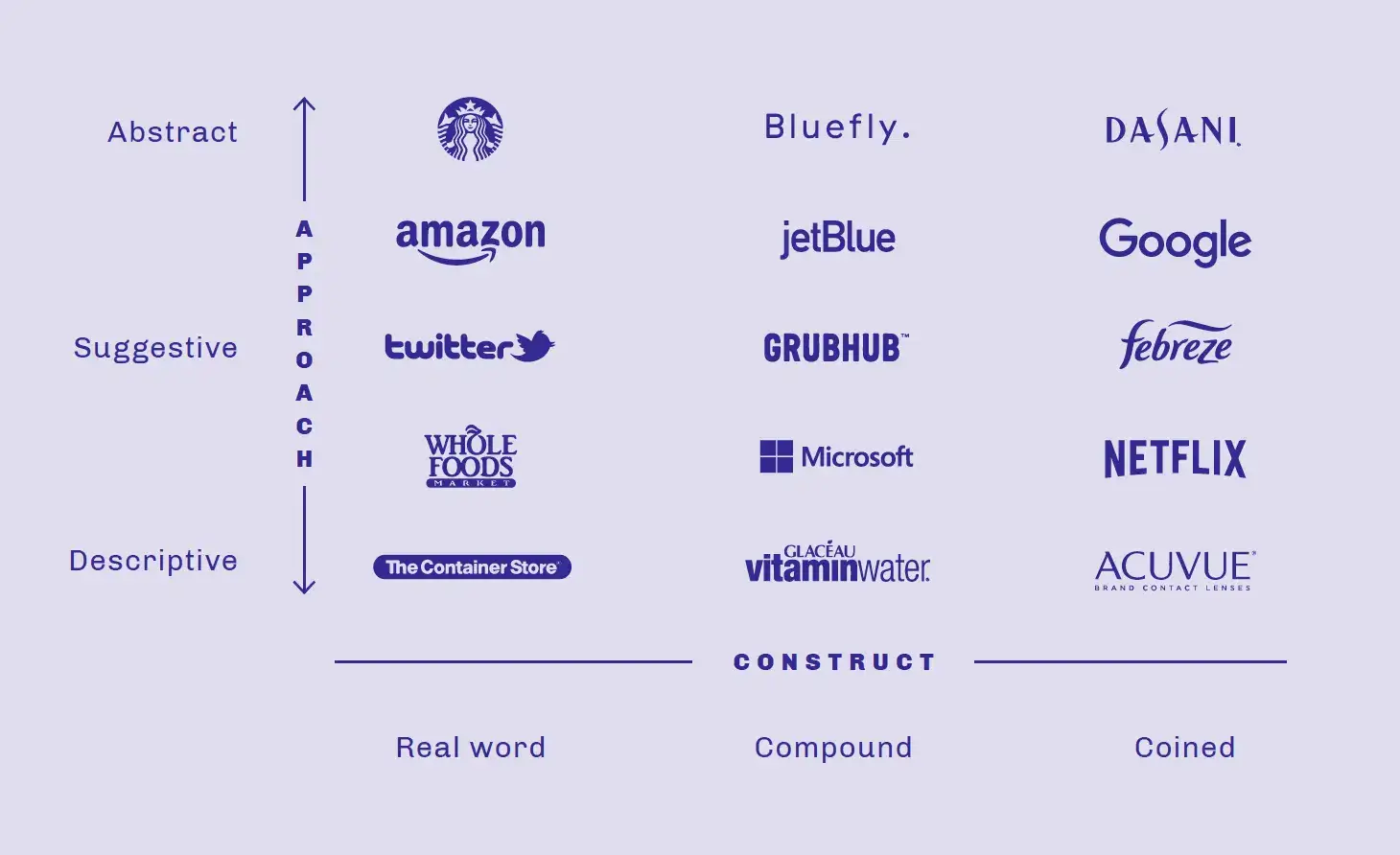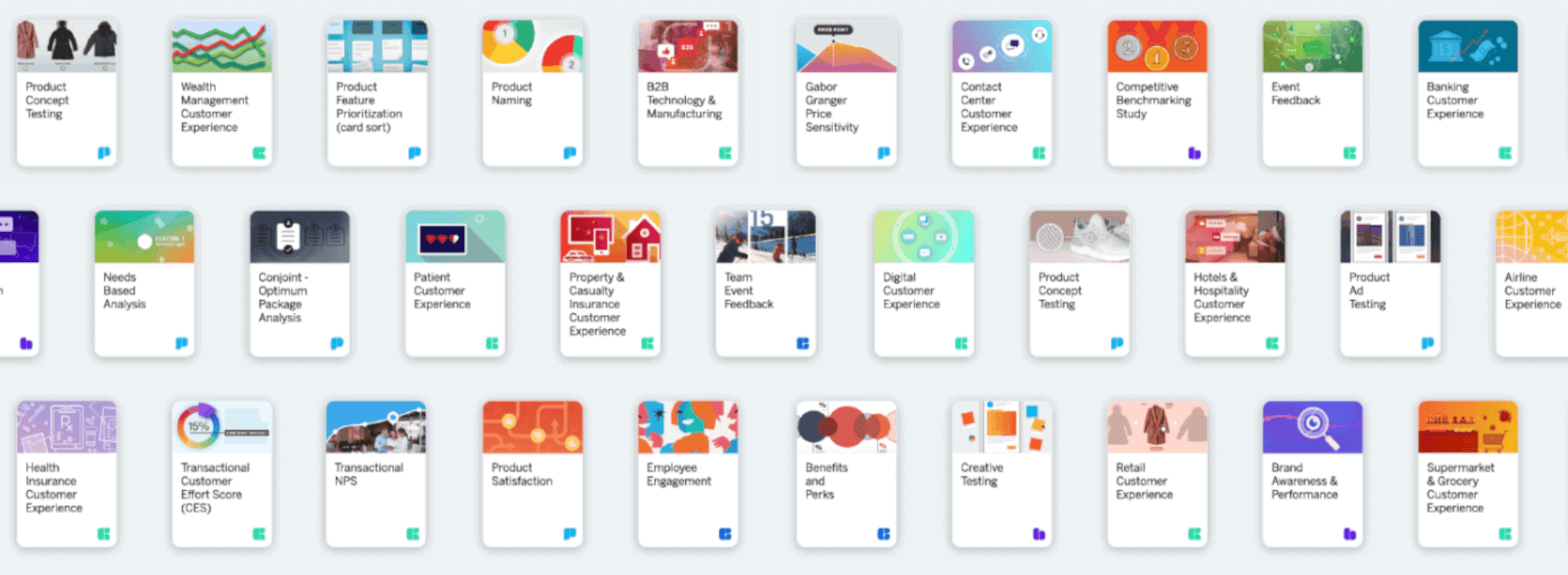When great brand naming collides with top-class products or services – and excellent customer and employee experience – you’ve got a winning combination that sets you apart in the market.
You want your brand naming to be memorable, talked about, and resonant with consumers. That’s why it’s important to pick a good one right from the start.
Did you know Amazon was originally going to be called ‘Cadabra’ – a contraction of ‘Abracadabra’ – but the name was shelved because it kept being misheard as ‘Cadaver’? Since web listings at the time were alphabetical, Jeff Bezos wanted something beginning with A that reflected the enormity of his corporate vision – the Amazon river.
As the business expanded into offering huge volumes of products and services, this name keeps up with that scope. And Steve Jobs, the story goes, was on a fruitarian diet when he came up with Apple, although the fact that Apple would be web-listed alphabetically ahead of Atari was probably significant.

Logotype collection of some of the most famous brands in the world on a screen – including Adidas, Nestle, Nike, McDonald’s, Sony, Facebook, Ikea, Pepsi, and much more printed on quality paper and shot with a high-resolution camera.
We’re not all like Steve Jobs though: brand naming cannot be defined as ‘good’ just because you like what you come up with. They’re good because they communicate a message to your audience. Great brand naming lets current and potential customers:
● Identify you
● Understand what you offer
● Understand its relevance to them
Brand naming that’s easy to recall, distinctive, and emotionally appealing will be more memorable and set your business up for success.
This process never stops; your audience will always want convenient ways to help them with their buying process, and trusting a brand enough to repurchase helps massively. Strong brand naming can help you differentiate yourself, and can be a huge asset to the brand’s identity.
But it’s important to note the difference between distinctiveness and differentiation. Whilst both are vital, they have their unique meanings:
– Differentiation
This is the reason or benefit that makes the customer choose your brand over another
– Distinctiveness
This is where a brand stands out from the others and is easily identifiable
Nike and Apple are two examples of brand naming and branding in general that combine the two qualities: they are both distinctive and easily recognisable by their name, logos, product design, websites, and retail stores, and they differentiate themselves from their competitors in doing so.
As a behavioural scientist and best-selling author Richard Shotton explains in his book The Choice Factory, research tells us that we are drawn to objects, people, and more distinctive places. We are hardwired to do this – it’s a behavioural reflex.
Why a good brand name is so important
Google. Uber. IKEA. Starbucks. Pepsi. You only have to hear these names and you instantly envisage what each company provides. Getting the right name can add real long-term value to your brand.
The best name:
- Is easy to remember, making your brand instantly memorable
- Makes sense, helping consumers understand what you do or provide
- Piques interest, encouraging a second look
- Symbolises positive sentiment and loyalty to your brand
- Is distinctive, helping distinguish your brand from competitors
- Is shareable, across social media
- Helps your brand own a space, sector, or industry
- Is flexible – so you can expand or add products or services easily
- Is trademarked, so nobody else can use it
The best brands in the world have made their names synonymous with the product or service they’re selling. People buy not just a product, but the brand, and this even has a proven positive knock-on effect on employee experience, customer experience, and revenue.
The importance of a brand naming strategy
Sometimes in life, we stumble upon a genius solution to a problem through pure serendipity, but we’d advise against hoping for that with your brand naming. Pulling names out of a hat and picking one that sounds good is about as far from a properly strategic brand naming process as you can get, and it’ll open the door to issues down the line.
Without a brand naming strategy in place, your name may put you at a disadvantage in a bunch of ways. It might not let you scale your business. It might not clearly express your vision. And, worst of all, customers and employees might hate it!

A robust, strategic brand naming process will help you mitigate all these issues, resulting in a brand name that’s got some empirical rationale behind it – and one that your target audience will remember.
Here are two quick stats to keep in mind:
- A customer needs to see your branding around 5-7 times to remember it
- It takes 7 seconds to make that first impression
So standing out is key. Your brand name needs to work hard to bring that number of impressions – and the time taken to make it – down.
Common brand naming mistakes (and how to avoid them)…
Thinking a great name will do all the work
Your brand name is a hugely important part of your overall branding, but it can’t do all the heavy lifting. Instead, brand naming works alongside, visual design, marketing, the customer experience, and the strength of your product offering. All of these facets of your business are ultimately what build a brand, and what will resonate with your target audience.
Thinking every single stakeholder has to like it
The more people you have involved in the brand naming process, the better. But it’s unwise to assume you can choose a name that absolutely everyone will love. No matter how backed-up by airtight rationale your brand name is, names are subjective entities – so some people 9customers or employees) will always dislike the one you choose. The key is to find a name that the majority of people love, rather than looking for unanimous appeal.
Not setting out with a clear brand naming process and strategy
Ok, ok, we know we’re repeating the point, but it really is crucial for the longevity and success of your brand name that you go about choosing one as part of a scientific brand naming process – rather than an emotional one. And that includes tracking associated KPIs – which we’ll get onto shortly.
Brand naming strategy: The naming process explained
So what is the brand naming process? How can you go from picking brand names out of a hat to an actual strategic brand naming process? And how can your overall brand-building strategy benefit from a brilliant brand name?
Here are five steps to creating a brand name people will love and remember…
Brand naming process step 1: Set clear objectives
Brand names are an extension of brands as a whole, so you first need to decide what you want yours to do.
Will it just be a company name, or will it be on product labels and service idents too? Think creatively about the journey you want your brand name to go on and outline your ambitions. You’ll need to run this past your stakeholders.
Brand naming process step 2: Define your core identity
Your brand name represents what your company stands for, so you’ll need to figure out:
- Who you are
- What you want people to think when they encounter your business
- How you will meet the needs of your customers
- The vision that your employees buy into
If you don’t know what these needs and values are, or how to meet them, then you can undertake market research to find out. As you begin to articulate your brand, take a long hard look at the following:
Brand purpose and brand mission:
This is why your company exists. Your business was set up for a reason: to solve a certain problem, service a particular need, or meet customer demand. This is your brand purpose. It’s why you get up in the morning, and it’s at the heart of the decisions you make as a business.
Brand vision:
What will the future look like? Not just for you, but for your employees and customers too. It’s essential to have an end goal, or a future state to work towards. This helps to turn your strategy into reality.
Brand attributes:
What are the pillars that your brand will stand for? What is the vision based on? Is it ‘fun’, ‘easy to use’, or ‘premium’? Identifying these will help make your brand stand out from the competition.
Brand personality:
How is your brand perceived by target customers? What images, colours, and fonts will you use to represent your brand? What tone of voice (TOV) best defines you?
Brand values:
What do you represent? A company is only as good as the people who work there. Your brand values form a framework that lets you create a culture where everyone can thrive. They are vital to the employee experience, helping you recruit the right people, and stay true to who you are while your company grows. They are also the principles that govern behaviour in the workplace, and that of the business.
Brand naming process step 3: Create user personas
A user persona is a fictional representation of your typical customer. Before you even begin brainstorming your brand name, make sure that you have created a distinct user persona or set of personas that you can use to test your ideas from a customer’s perspective.
Once you know who you’re branding your company for, you’ll have an easier time choosing a suitable name. Your user personas will help you empathise with the people you want to sell your products and services to, so you can choose a name that resonates with your customers.
Brand naming process step 4: Name your brand
This is where the fun starts. As you build out your identity, collaborate with stakeholders, teams, and potential customers to ensure a diversity of opinions that allows you to take in the bigger picture.
Bring key stakeholders and creatives together and begin by coming up with words that you feel represent your brand (phrases, names, places, adjectives). You may decide to do this in a more structured way and frame your ideas through certain categories. You can try:
Personal
This might be the first name and/or last name of your founders, such as John Deere or Walt Disney. Or it might be based on the name of someone else who was significant in creating the company
Based on service
A descriptive word that outlines what you do, as with Deliveroo, YouTube, and Reddit.

Image Source: How brands are built
Acronym
An abbreviation of names, or a phrase, as with KFC, MTV, and Duracell. Ingvar Kamprad Elmtaryd Agunnaryd doesn’t sound particularly snappy until you use the initials – IKEA.
Metaphor
A word that symbolises the future state or feeling that you are trying to create as a business: Verizon, Fanta, Patagonia.
Or you could make up a word – Etsy, Google, GoDaddy, Skype. Making up a word for a brand name can be a gamble (will it be easily read, pronounced, and remembered?), but it can help on a very practical level since the .com domains for made-up words will be more readily available.
Begin by making a list of words that appeal to you. Not only will this help you to create your brand name, but it will also inform the creation of your logo and other brand assets. You’re articulating the brand’s personality, not just the name.
Don’t forget to check that your chosen names are available and not in use or trademarked by anyone else.
Brand naming process step 5: Test your ideas
Once you get a list of suitable, available names, you can begin testing them, both in-house and more importantly, externally with potential customers. Getting a different perspective will help you avoid making mistakes. Your brand name needs to:
- Be easy to spell and pronounce
- Sound good and clear on the telephone
- Avoid any confusion
- Reflect brand personality
- Have an available URL
Use both qualitative and quantitative data to test your creative development – surveys, focus groups, and interviews will help understand which brand names resonate, which don’t, and why. Use analytics tools to help you to unlock insights and prioritise the key drivers that matter to your audience.
Once you’ve analysed your potential brand names, you can see which ones resonate with your audience the most. Use this feedback to act on and improve them if necessary. That might be word length, tone, or perhaps how they translate in different languages and cultures. Or they might not resonate with customers, in which case you need to assess why.
And finally – trademark your brand so present and future competitors cannot use it.
Launch and grow your brand with the right tools

Then, as you focus your efforts on growing the brand, you’ll want to see how those efforts pay off. The only way to do that is by measuring with a brand experience program, where you’ll be able to track your progress and ensure your efforts produce results. With a brand tracker, you’ll be able to:
- Measure essential brand KPIs, e.g. brand awareness and consideration
- Understand how distinct your brand is from competitors
- Identify the key attributes that resonate (or don’t resonate) with your audience
- Find the drivers that can improve awareness and other key goals for your brand
- Keep an eye on short-term trends based on social and review data
- Integrate operational (O) data, such as revenue and ad spend so you can connect your brand tactics with business outcomes
Ultimately, a brand experience tool ensures you’re on the right track towards your brand goals – whether you want to be Apple or Nike.
Increase loyalty with a consistently strong brand
Arriving at brand naming that really resonates is just one part of the puzzle. We already mentioned that this will sit alongside your marketing, visual design, and other elements, but it’s worth reiterating because aligning all these parts of your brand can have a huge impact on customer loyalty.
Did you know that being consistent with your branding across all platforms can increase revenue by up to 23%?
People expect to have the same experience – whether that’s simply visual, or more meaningful and interactive – wherever they go, so ensuring you have an airtight, uniform approach to your branding and brand experience is a must.
You can measure the strength and uniformity of your overall brand identity by conducting surveys, running a social listening program, or through always-on feedback, as is offered by Qualtrics Brand XM.
eBook: The State of Brand Experience Management